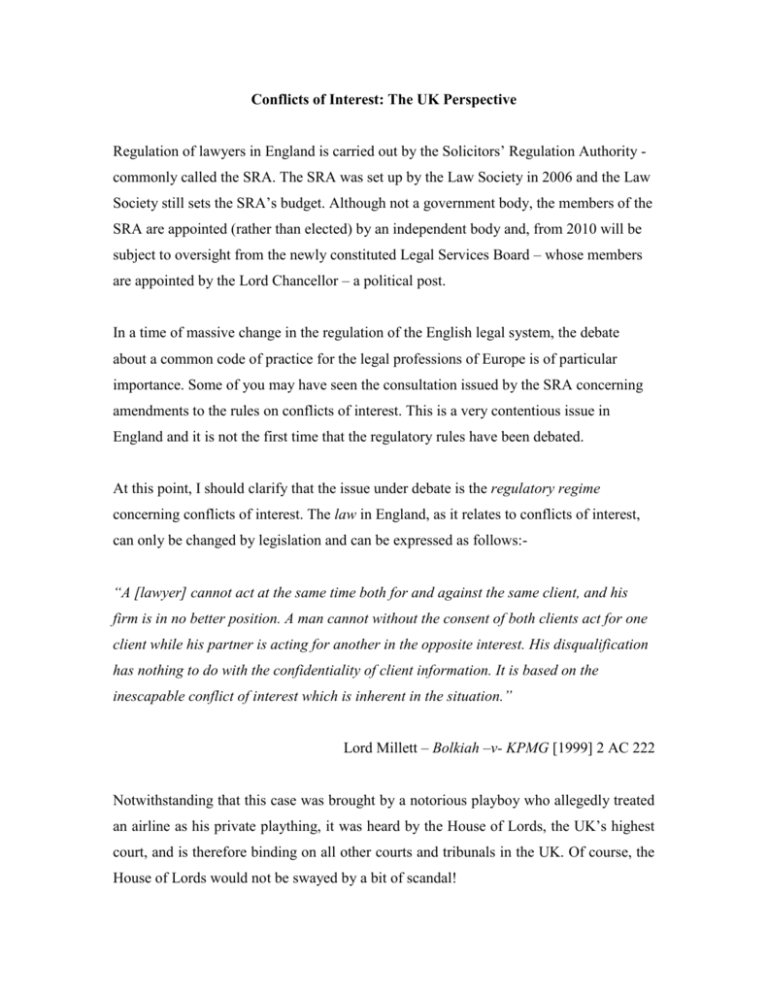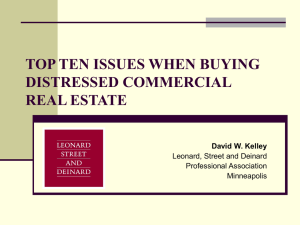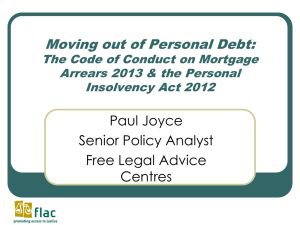Conflicts of Interest: The UK Perspective
advertisement

Conflicts of Interest: The UK Perspective Regulation of lawyers in England is carried out by the Solicitors’ Regulation Authority commonly called the SRA. The SRA was set up by the Law Society in 2006 and the Law Society still sets the SRA’s budget. Although not a government body, the members of the SRA are appointed (rather than elected) by an independent body and, from 2010 will be subject to oversight from the newly constituted Legal Services Board – whose members are appointed by the Lord Chancellor – a political post. In a time of massive change in the regulation of the English legal system, the debate about a common code of practice for the legal professions of Europe is of particular importance. Some of you may have seen the consultation issued by the SRA concerning amendments to the rules on conflicts of interest. This is a very contentious issue in England and it is not the first time that the regulatory rules have been debated. At this point, I should clarify that the issue under debate is the regulatory regime concerning conflicts of interest. The law in England, as it relates to conflicts of interest, can only be changed by legislation and can be expressed as follows:“A [lawyer] cannot act at the same time both for and against the same client, and his firm is in no better position. A man cannot without the consent of both clients act for one client while his partner is acting for another in the opposite interest. His disqualification has nothing to do with the confidentiality of client information. It is based on the inescapable conflict of interest which is inherent in the situation.” Lord Millett – Bolkiah –v- KPMG [1999] 2 AC 222 Notwithstanding that this case was brought by a notorious playboy who allegedly treated an airline as his private plaything, it was heard by the House of Lords, the UK’s highest court, and is therefore binding on all other courts and tribunals in the UK. Of course, the House of Lords would not be swayed by a bit of scandal! There is, of course, a fundamental difference between the law and the regulatory regime. The regulatory regime allows the SRA to take action against solicitors for acting in breach of the rules whether or not the client has complained and provides a non-judicial avenue to make a complaint; the common law gives an individual client the right to challenge his solicitors in court and, if necessary, prevent them from acting for a third party. The most recent (and high profile) example of this in the UK was the case of Marks and Spencers Plc –v- Freshfields Bruckhaus Derringer. The case concerned an attempted hostile takeover of Marks & Spencer by a consortium led by the entrepreneur Philip Green. Freshfields had acted for Marks and Spencer in some non-contentious transactions and it maintained that there was no conflict of interest if it acted for Mr Green’s consortium, or, if there was, it could be managed so as not to risk client confidentiality. Marks and Spencer disagreed and sought an injunction preventing Freshfields from acting for Mr Green’s consortium. There are those who consider that the litigation was tactical, designed simply to delay the attempt at hostile takeover and that Marks and Spencer would not have objected but for the opportunity to derail the bid – which ultimately worked. In any event, the Court of Appeal upheld Marks and Spencer’s position and refused an appeal against the injunction. It is perhaps interesting that the case was brought by a sophisticated corporation with access to vast resources – including advice from one of the largest law firms in the UK against another of the largest law firms in the UK and was strongly contested on both sides. It may be reasonable to assume therefore that the question “what is a conflict of interests?” is harder to determine in practice than it first appears. The Court of Appeal had no hesitation in finding that there was a conflict of interests however Freshfields and those advising them obviously felt that there was none at the time. In this case, the SRA reviewed the finding of the Court and issued disciplinary proceedings against the solicitor involved. He was ultimately fined £9,000 and ordered to pay £50,000 in costs. But for the Court action, it is unlikely that the SRA would ever have identified an issue or taken any action in this particular case. That said the SRA does frequently investigate allegations of conflicts of interest. The more serious allegations usually relate to a conflict between the interests of the solicitor and their own client but such allegations can take many forms and often, the client may have been wholly unaware that the solicitor was acting improperly. It is this general imbalance of power and knowledge between lawyers and their lay clients which has led the SRA to impose more restrictive rules in an effort to ensure that lawyers do not take unfair advantage of their clients. These more restrictive rules are not without difficulty, notwithstanding that, in their current incarnation, they have only been in force for around four years and there is an ongoing debate, driven principally by “City”1 firms (such as Freshfields) concerning whether our regulator’s conflict of interest rules should be relaxed – yet again. Some of you may have seen the SRA’s consultation on the subject. Indeed, at the beginning of September, the SRA published an analysis of responses confirming that the rules would be amended. We await with eager anticipation the SRA’s proposals for the amendments and the further consultation on the draft rules, due to be issued in autumn 2009. It is perhaps helpful at this stage to sound a note of caution; lessons from the past have shown that there are real risks in relaxing rules relating to conflicts of interest. The two most striking examples are in relation to the sale and purchase of property and referral fees. You should be aware that the legal aspects of property transactions are usually handled by solicitors. It has been permitted for a solicitor to act for both the buyer of a property and the mortgage lender for many years. There are a number of safeguards in place, including the 1 large, mainly multinational firms which act for large corporate clients requirement to comply with the requirements of a set of standardised instructions, called the Council of Mortgage Lenders’ Handbook. The current recession (and indeed, the recession in the early 1990s) has thrown into sharp relief the problems of mortgage fraud. In many instances, mortgage fraud has been allowed to occur because a solicitor fails to recognise his obligations to disclose relevant information to lender clients. This failure is, of course, very bad news for the reputation of our profession when the issue of fraud hits the headlines. It can be said that there are strong commercial reasons for permitting solicitors to act for both lender and purchaser because it ultimately reduces the cost to the purchaser by cutting out one set of legal fees. One must however ask whether the profession should yield to commercial pressure to waive, amend or reduce professional obligations. Is it not the case that our collective reputation suffers – and costs to the consumer are ultimately increased – by the opportunities for fraud or error? It is, of course, a regulator’s invariable response to large scale issues of fraud, that regulation should be increased. There should be more oversight and more rules and the costs of compliance are thus increased – and passed on to the consumer. The same sorry story is true of the relaxation of rules relating to the referral of clients and payment of referral fees. The rules were relaxed five years ago and already a massive referral industry has been created, covering many areas of law. Personal injury is by far the largest target and the so-called “claims farmers” have certainly done their bit for the reputation of the profession. Solicitors do, of course, have an interest in keeping the referral company happy; is this interest consistent with their duties to clients? Sometimes, the answer will be a resounding yes but there is a real and increasing risk that overreliance on referral companies will lead to a serious conflict of interest arising. As I have already said, the regulator’s rules as they currently stand are more stringent than the common law rules and it is a disciplinary matter if they are contravened. In the event that a client complains to the Legal Complaints Service, there is also a statutory power for the Legal Complaints Service to award some compensation. There is, of course, the problem that many clients would not recognise a conflict of interest and would not know that they had a right to complain. I have provided a copy of the current rules, in their entirety, as an attachment to this speech. I am quite sure that we have better things to discuss today than simply repeating the rules (which are likely to be amended soon in any event). You can see that the basic rule in respect of conflicts of interest is not to act where:- a) you are acting for another client with conflicting or potentially conflicting interests; and b) your interests (or those of your firm) are or may be in conflict with the interests of your client. This basic rule is subject to several exceptions, all of which require that certain conditions are met and that the clients all consent in writing to you acting. The most common exception relied upon is where you are acting for two clients who have “substantially common interests.” This would cover situations where, for example, you are asked to advise both clients on a joint venture and its potential ramifications. It may also cover advising joint claimants or defendants in litigation in some circumstances. It is important to note that, where a solicitor is relying on an exception to the duty not to act, it must be reasonable in all of the circumstances for him to act. The SRA will expect the solicitor to demonstrate that he can act for both clients properly, without fear or favour affecting his advice to either one. There is also a continuing requirement to ensure that it remains reasonable for the solicitor to act throughout the retainer. The new rule is widely anticipated to have a broader exception, to permit firms to act where there is or may be a conflict of interest provided the clients are “sophisticated” and have consented to the firm so acting. There is likely to be substantial debate about the definition of “sophisticated client.” As matters stand, the definition of sophisticated client is likely to be limited to clients with their own in house legal departments or those who have taken independent legal advice before confirming that they will waive the conflict. There is also clear scope for clients to argue about the consent that they have given. There may be difficulties regarding clients claiming, for tactical reasons, that the consent was given based on a misunderstanding or mistaken information and should be withdrawn. It is my view that there is a potential minefield for solicitors here and it remains to be seen how the SRA will address the issues in the draft rules. It is likely that the English authorities will continue to interpret any amendments to the rules in favour of the client. The courts take the view that the rules are there for the protection of clients and solicitors should not be able to get around the substance of the rules by focussing on a strict interpretation of the wording. The courts consistently emphasise that a solicitor’s duty to act in the best interest of his client is second only to the solicitor’s duty to the court and to maintaining the rule of law. Against this background then, it is likely that solicitors will have to demonstrate that they have explained, in some detail, the potential ramifications of their acting in a situation of conflict. I suspect that a failure to fully explain the nature and effect of a potential conflict of interest will lead to any written consent being set aside. Turning now to the potential sanctions for acting where there is a conflict of interest, it is of note that most cases involving conflicts of interest referred to the Solicitors Disciplinary Tribunal fall into one of four main categories:- 1. The solicitor has acted for both purchaser and mortgage company in a property transaction and has failed to inform the mortgage company of a potential conflict of interest; 2. The solicitor has acted for a client where he (the solicitor) is the other party so, for example, a solicitor takes a loan from a client or buys a property from or sells a property to a client; 3. The solicitor has acted for a client where he has a personal relationship with a third party interested in the transaction in one way or another; for example, referring a client to a family member who is perhaps a barrister, or acting for a client where a family member is the other party to the transaction; 4. The solicitor has entered into a referral arrangement with a third party which may compromise his ability to advise the client independently or put confidential information at risk. It is uncommon for solicitors to be wholly prevented from practising, either permanently or temporarily, because they have acted in a situation of conflict of interest on a one off occasion, although such conduct is regarded as serious. That is not to say it is not possible, particularly where the conduct is deliberate or grossly improper. The position tends to be addressed by the imposition of a reprimand or fine, depending on circumstances and it is possible that a solicitor may have conditions imposed on his or her practising certificate. Repeated or deliberate infractions would be likely to lead to a more serious sanction. I should mention at this stage that the SRA is going to be given new powers to publicly fine and rebuke solicitors for misconduct directly. At present, the SRA’s disciplinary powers are limited to internal sanctions and all formal powers are exercised by the Solicitors Disciplinary Tribunal. The changes are designed to increase proportionality and reduce the cost of prosecuting misconduct at the lower end of the scale. It is likely that many of the less serious allegations of conflict of interest will be dealt with in this manner in the future. The question of publicity is a thorny one. Any public rebukes or fines issued by the SRA – which will be issued without a formal hearing – will be published on the SRA’s fully searchable database for a default period of three years unless the solicitor can demonstrate that they should not be published – no easy task, I assure you. Publicity is consistent with the SRA’s new publicity policy. It is their view that transparency in regulation requires that disciplinary decisions be published, save in exceptional circumstances. I must confess that I do not share the SRA’s view on this point, either in principle or in practice – but that is a debate for another day. On a slightly separate point, the question of publicity is relevant to all lawyers wishing to practise in the UK. Any Registered European Lawyers or Registered Foreign Lawyers effectively submit to the jurisdiction of the SRA and, of course, the searchable database is online and is searchable from anywhere in the world. It may be the case therefore that foreign lawyers who work in England and are found to have breached the rules will be the subject of adverse publicity in their home bar notwithstanding that the rules of their home jurisdiction would not have been infringed. These are, I believe, serious issues facing the legal profession in the UK at present. At this stage, I would like to say a few words about client confidentiality. In many ways, confidentiality is one of the overriding concerns when considering conflicts of interest and many of my earlier comments may be taken simply to include client confidentiality as an element to consider in the wider context of conflicts of interest. It must be emphasised though that client confidentiality is a distinct duty owed by every solicitor to each of his clients. A solicitor also owes a duty to each client to inform them of relevant information which comes to that solicitor’s personal attention, no matter the source. It is easy to see how these duties might conflict when advising clients in situations of an actual or potential conflict of interest. The current rules make it clear that the duty of confidentiality is paramount but it is likely that the solicitor affected would have to cease acting for one or both clients as he can no longer fulfil his competing duties to both. In summary then, I think it is fair to say that a solicitor who acts where there is a conflict of interest is potentially in grave professional danger. Although there are situations where it is permissible to act in circumstances of a conflict of interest, there are numerous difficulties, particularly if matters become contentious. There are calls for relaxation of the rules and these calls are likely to be followed. My perhaps somewhat cynical opinion is that this will only lead to more complex rules which are more open to abuse. I am guessing that we will have to wait some time before the true effect of the changes becomes clear. Susanna Heley City of Westminster & Holborn Law Society RadcliffesLeBrasseur 5 Great College Street London SW1P 3SJ ANNEX 1 Rule 3.01 Duty not to act (1) You must not act if there is a conflict of interests (except in the limited circumstances dealt with in 3.02). (2) There is a conflict of interests if: (a) o you owe, or your firm owes, separate duties to act in the best interests of two or more clients in relation to the same or related matters, and those duties conflict, or there is a significant risk that those duties may conflict; or (b) your duty to act in the best interests of any client in relation to a matter conflicts, or there is a significant risk that it may conflict, with your own interests in relation to that or a related matter. o (3) For the purpose of 3.01(2), a related matter will always include any other matter which involves the same asset or liability. 3.02 Exceptions to duty not to act o o (1) You or your firm may act for two or more clients in relation to a matter in situations of conflict or possible conflict if: (a) the different clients have a substantially common interest in relation to that matter or a particular aspect of it; and (b) all the clients have given in writing their informed consent to you or your firm acting. (2) Your firm may act for two or more clients in relation to a matter in situations of conflict or possible conflict if: o o o o (a) the clients are competing for the same asset which, if attained by one client, will make that asset unattainable to the other client(s); (b) there is no other conflict, or significant risk of conflict, between the interests of any of the clients in relation to that matter; (c) the clients have confirmed in writing that they want your firm to act in the knowledge that your firm acts, or may act, for one or more other clients who are competing for the same asset; and (d) unless the clients specifically agree, no individual acts for, or is responsible for the supervision of, more than one of those clients. (3) When acting in accordance with 3.02(1) or (2) it must be reasonable in all the circumstances for you or your firm to act for all those clients. (4) o If you are relying on the exceptions in 3.02(1) or (2), you must: (a) draw all the relevant issues to the attention of the clients before agreeing to act or, where already acting, when the conflict arises or as soon as is reasonably practicable, and in such a way that the clients concerned can understand the issues and the risks involved; (b) have a reasonable belief that the clients understand the relevant (c) be reasonably satisfied that those clients are of full capacity. o o issues; and 3.03 Conflict when already acting If you act, or your firm acts, for more than one client in a matter and, during the course of the conduct of that matter, a conflict arises between the interests of two or more of those clients, you, or your firm, may only continue to act for one of the clients (or a group of clients between whom there is no conflict) provided that the duty of confidentiality to the other client(s) is not put at risk. 3.04 Accepting gifts from clients Where a client proposes to make a lifetime gift or a gift on death to, or for the benefit of: (a) you; (b) any manager, owner or employee of your (c) a family member of any of the above, firm; and the gift is of a significant amount, either in itself or having regard to the size of the client's estate and the reasonable expectations of the prospective beneficiaries, you must advise the client to take independent advice about the gift, unless the client is a member of the beneficiary's family. If the client refuses, you must stop acting for the client in relation to the gift. 3.05 Public office or appointment leading to conflict You must decline to act where you, a member of your family, or a manager, owner or employee of your firm holds some public office or appointment as a result of which: (a) a conflict of interests, or a significant risk of a conflict, arises; (b) the public might reasonably conclude that you, or your firm, had been able to make use of the office or appointment for the advantage of the client; or (c) your ability to advise the client properly and impartially is inhibited. 3.06 Alternative dispute resolution (ADR) If you provide ADR services you must not: (a) o advise or act for any party in respect of a dispute in which you or any person within your firm is acting, or has acted, as mediator; (b) provide ADR services in connection with a matter in which you or any person within your firm has acted for any party; or (c) provide ADR services where you or any person within your firm has acted for any of the parties in issues not relating to the mediation, unless that has been disclosed to the parties and they consent to your acting. o o 3.07 Acting for seller and buyer in conveyancing, property selling and mortgage related services (1) Rules 3.07 to 3.15 apply to the transfer of land for value, and the grant or assignment of a lease or some other interest in land for value. Both commercial and residential conveyancing transactions are covered. The terms "seller" and "buyer" include a lessor and lessee. "You" is defined in 23.01, but is to be construed in 3.07 to 3.15 as including an associated firm (see rule 24 (Interpretation) for the meaning of "associated firms"). (2) You must not act for more than one party in conveyancing, property selling or mortgage related services other than as permitted by, and in accordance with, 3.08 to 3.15. "Property selling" means negotiating the sale for the seller. "Mortgage related services" means advising on or arranging a mortgage, or providing mortgage related financial services, for a buyer. "Mortgage" includes a remortgage. 3.08 Conveyancing transactions not at arm's length Subject to the prohibition in 10.06(3) and 10.06(4), you may act for seller and buyer when the transaction between the parties is not at arm's length, provided there is no conflict or significant risk of conflict. 3.09 Conveyancing transactions at arm's length Subject to the prohibition in 10.06(3) and (4), you may act for seller and buyer if the conditions set out in 3.10 below are satisfied and one of the following applies: o (a) o o both parties are established clients; (b) the consideration is £10,000 or less and the transaction is not the grant of a lease; or (c) seller and buyer are represented by two separate offices in different localities. 3.10 Conditions for acting under 3.09 In order to act for seller and buyer under 3.09 above, the following conditions must be met: o o o (a) the written consent of both parties must be obtained; (b) no conflict of interests must exist or arise; (c) the seller must not be selling or leasing as a builder or o developer; and (d) when the seller and buyer are represented by two separate offices in different localities: (i) different individuals authorised to do the work, who normally work at each office, conduct or supervise the transaction for seller and buyer; and (ii) no office of the firm (or an associated firm) referred either client to the office conducting the transactions. 3.11 Property selling and mortgage related services Subject to the prohibition in 10.06(3) and (4), you may act for seller and buyer if the conditions set out in 3.13 below are satisfied and one of the following applies: (a) o the only way in which you are acting for the buyer is in providing mortgage related services; or (b) the only way in which you are acting for the seller is in providing property selling services through a Solicitors' Estate Agency Limited (SEAL). o 3.12 SEALs and participating firms A SEAL means a recognised body which: o o (a) is a company; (b) does not undertake conveyancing; (c) o is owned jointly by at least four participating firms which are not associated firms; (d) o has no participating firm with majority control; (e) o has at least one participating firm which is a recognised body or recognised sole practitioner; and (f) is conducted from accommodation physically divided from, and clearly differentiated from that of any participating firm. o o A "participating firm" means a recognised sole practitioner, recognised body or authorised non-SRA firm which is a manager or owner of the SEAL, or one or more of whose managers or owners is a manager or owner of the SEAL. 3.13 Conditions for acting under 3.11 In order to act for seller and buyer under 3.11 above, the following conditions must be met: (a) the written consent of both parties must be obtained; (b) no conflict of interests must exist or arise; (c) the seller must not be selling or leasing as a builder or o o (d) different individuals must conduct the work for the seller and the work for the buyer and, if these individuals need supervision, they must be supervised by different individuals who are authorised to do the work; (e) you must inform the seller in writing, before accepting instructions to deal with the property selling, of any services which might be offered to a buyer, whether through the same firm or any associated firm; and (f) o developer; you must explain to the buyer, before the buyer gives consent to the arrangement: (i) the implications of a conflict of interests arising; (ii) your financial interest in the sale going through; and (iii) if you propose to provide mortgage related services to the buyer through a SEAL which is also acting for the seller, that you cannot advise the buyer on the merits of the purchase. 3.14 Special circumstances in property selling and conveyancing If any of the circumstances set out in 3.09 apply (established clients; consideration of £10,000 or less; representation by two separate offices), you may sell the property, provide mortgage related services, and act for seller and buyer in the conveyancing, subject to the prohibition in 10.06(3) and (4) and compliance with the conditions set out in 3.10 and 3.13 as appropriate. 3.15 Conflict arising when acting for seller and buyer If a conflict arises during the course of a transaction in which you are acting for more than one party, you may continue to act for one of the parties only if the duty of confidentiality to the other party is not at risk. 3.16 Acting for lender and borrower in conveyancing transactions (1) Rules 3.16 to 3.22 cover the grant of a mortgage of land and are intended to avoid conflicts of interests. "Mortgage" includes a remortgage. Both commercial and residential conveyancing transactions are covered. "You" is defined in 23.01, but is to be construed in 3.16 to 3.22 as including an associated firm (see rule 24 (Interpretation) for the meaning of "associated firms"). (2) You must not act for both lender and borrower on the grant of a mortgage of land: (a) if a conflict of interests exists or arises; (b) on the grant of an individual mortgage of o o land at arm's length; (c) o if, in the case of a standard mortgage of property to be used as the borrower's private residence only, the lender's mortgage instructions extend beyond the limitations contained in 3.19 and 3.21, or do not permit the use of the certificate of title required by 3.20; or (d) if, in the case of any other standard mortgage, the lender's mortgage instructions extend beyond the limitations contained in 3.19 and 3.21. o 3.17 Standard and individual mortgages o o o (1) A mortgage is a "standard mortgage" where: (a) it is provided in the normal course of the lender's activities; (b) a significant part of the lender's activities consists of lending; and (c) the mortgage is on standard terms. An "individual mortgage" is any other mortgage. (2) A mortgage will not be on standard terms if material terms in any of the documents relating to the mortgage transaction are negotiated between the lender's and borrower's lawyers contemporaneously with effecting the mortgage. In commercial transactions, the element of negotiation will often relate to the facility letter or facility agreement rather than the mortgage deed itself. (3) Provided there has been no contemporaneous negotiation of material terms between the parties' lawyers, a mortgage will be on standard terms where the lender uses a prescribed form of mortgage deed. Minor variations, such as the usual clause limiting the liability of trustee mortgagors, are not regarded as material and do not alter the nature of these terms as standard. (4) In addition to its normal standard terms, a lender may have a different set or sets of standard terms applicable to specialised types of borrower, such as registered social landlords. Provided these terms are applied by the lender to all equivalent specialist borrowers or have been agreed between the lender and a specialist borrower as applicable to all transactions between them, they will constitute standard terms for the purposes of 3.16 to 3.22. (5) The lender and the borrower must be separately represented on the grant of an individual mortgage at arm's length (see 3.16(2)(b)). Rules 3.16 to 3.22 are not then applicable. (6) You may act for both lender and borrower in a standard mortgage (see 3.16(2)(c) to (d)), provided: (a) there is no conflict of interests; (b) the mortgage instructions do not o o o go beyond the limits set out in 3.19; and (c) in the case of a property to be used solely as the borrower's private residence, the approved certificate of title set out in the annex to rule 3 is used. (7) The limitations of 3.19 also apply to a standard mortgage where the lender and the borrower are separately represented (see 3.22(1) which includes certificates of title). However, 3.22(2) allows the borrower's lawyer, in a transaction where the property is not to be used solely as the borrower's private residence, to give a certificate of title in any form recognised by the Solicitors Regulation Authority Board. You also remain free to give any other form of certificate which complies with this rule. (8) There may be cases where the lapse of time between the mortgage offer and completion (for example, when new properties are added) results in use of an earlier edition of a recognised certificate. That is acceptable. 3.18 Notification of certain circumstances to lender If you wish to act for both lender and borrower on the grant of a standard mortgage of land, you must first inform the lender in writing of the circumstances if: (a) o o (1) the prospective borrower is: (i) the firm or any of its managers or owners, or a member of their immediate family; (ii) an associated firm, any of its managers or owners, or a member of their immediate family; and/or (iii) the individual conducting or supervising the transaction, or a member of their immediate family; or (b) you propose to act for seller, buyer and lender in the same transaction. (2) "Immediate family" means spouse, children, parents, brothers and sisters. 3.19 Types of instruction which may be accepted If acting for both lender and borrower in a standard mortgage, you and the individual conducting or supervising the transaction may only accept or act upon instructions from the lender which are limited to the following matters: (a) o o o o o o o o (i) taking reasonable steps to check the identity of the borrower (and anyone else required to sign the mortgage deed or other document connected with the mortgage) by reference to a document or documents, such as a passport, precisely specified in writing by the lender; (ii) following the guidance given by the Law Society or the Solicitors Regulation Authority on property fraud and on money laundering; (iii) checking that the seller's conveyancers (if unknown to you) appear in a current legal directory or hold practising certificates issued by their professional body; and (iv) in the case of a lender with no branch office within reasonable proximity of the borrower, carrying out the money laundering checks precisely specified in writing by the lender; (b) making appropriate searches relating to the property in public registers (for example, local searches, commons registration searches, mining searches), and reporting any results specified by the lender or which you consider may adversely affect the lender; or effecting search insurance; (c) making enquiries on legal matters relating to the property reasonably specified by the lender, and reporting the replies; (d) reporting the purchase price stated in the transfer and on how the borrower says that the purchase money (other than the mortgage advance) is to be provided; and reporting if you will not have control over the payment of all the purchase money (other than a deposit paid to an estate agent or a reservation fee paid to a builder or developer); (e) reporting if the seller or the borrower (if the property is already owned by the borrower) has not owned or been the registered owner of the property for at least six months; (f) if the lender does not arrange insurance, confirming receipt of satisfactory evidence that the buildings insurance is in place for at least the sum required by the lender and covers the risks specified by the lender; giving notice to the insurer of the lender's interest and requesting confirmation that the insurer will notify the lender if the policy is not renewed or is cancelled; and supplying particulars of the insurance and the last premium receipt to the lender; (g) investigating title to the property and appurtenant rights; reporting any defects revealed, advising on the need for any consequential statutory declarations or indemnity insurance, and approving and effecting indemnity cover if required by the lender; and reporting if you are aware of any rights needed for the use or enjoyment of the property over other land; (h) reporting on any financial charges (for example, improvement or repair grants or Housing Act discounts) secured on the property revealed by your searches and enquiries which will affect the property after completion of the mortgage; (i) o in the case of a leasehold property: (i) confirming that the lease contains the terms stipulated by the lender and does not include any terms specified by the lender as unacceptable; (ii) obtaining a suitable deed of variation or indemnity insurance if the terms of the lease are unsatisfactory; (iii) enquiring of the seller or the borrower (if the property is already owned by the borrower) as to any known breaches of covenant by the landlord or any superior landlord and reporting any such breaches to the lender; (iv) reporting if you become aware of the landlord's absence or insolvency; (v) making a company search and checking the last three years' published accounts of any management company with responsibilities under the lease; (vi) if the borrower is required to be a shareholder in the management company, obtaining the share certificate, a blank stock transfer form signed by the borrower and a copy of the memorandum and articles of association; (vii) obtaining any necessary consent to or prior approval of the assignment and mortgage; (viii) obtaining a clear receipt for the last payment of rent and service charge; and (ix) serving notice of the assignment and mortgage on the landlord; (j) o in the case of a commonhold unit: (i) confirming receipt of satisfactory evidence that common parts insurance is in place for at least the sum required by the lender and covers the risks specified by the lender; (ii) confirming that the commonhold community statement contains the terms specified by the lender and does not include any restrictions on occupation or use specified by the lender as unacceptable; (iii) enquiring of the seller (or the borrower if the property is already owned by the borrower) and the commonhold association as to any known breaches of the commonhold community statement by the commonhold association or any unit-holder, and reporting any such breaches to the lender; (iv) making a company search to verify that the commonhold association is in existence and remains registered, and that there is no registered indication that it is to be wound up; (v) obtaining the last three years' published accounts of the commonhold association and reporting any apparent problems with the association to the lender; (vi) o o (vii) obtaining a commonhold unit information certificate; and serving notice of the transfer and mortgage of the commonhold unit on the commonhold association; (k) if the property is subject to a letting, checking that the type of letting and its terms comply with the lender's requirements; (l) making appropriate pre-completion searches, including a bankruptcy search against the borrower, any other person in whom the legal estate is vested and any guarantor; o o o o o o o o o (m) receiving, releasing and transmitting the mortgage advance, including asking for any final inspection needed and dealing with any retentions and cashbacks; (n) procuring execution of the mortgage deed and form of guarantee as appropriate by the persons whose identities have been checked in accordance with any requirements of the lender under (a) above as those of the borrower, any other person in whom the legal estate is vested and any guarantor; obtaining their signatures to the forms of undertaking required by the lender in relation to the use, occupation or physical state of the property; and complying with the lender's requirements if any document is to be executed under a power of attorney; (o) asking the borrower for confirmation that the information about occupants given in the mortgage instructions or offer is correct; obtaining consents in the form required by the lender from existing or prospective occupiers of the property aged 17 or over specified by the lender, or of whom you are aware; (p) advising the borrower on the terms of any document required by the lender to be signed by the borrower; (q) advising any other person required to sign any document on the terms of that document or, if there is a conflict of interests between that person and the borrower or the lender, advising that person on the need for separate legal advice and arranging for them to see an independent conveyancer; (r) btaining the legal transfer of the property to the mortgagor; (s) procuring the redemption of: (i) existing mortgages on property the subject of any associated sale of which you are aware; and (ii) any other mortgages secured against a property located in England or Wales made by an identified lender where an identified account number or numbers or a property address has been given by the lender; (t) ensuring the redemption or postponement of existing mortgages on the property, and registering the mortgage with the priority required by the lender; (u) making administrative arrangements in relation to any collateral security, such as an endowment policy, or in relation to any collateral warranty or guarantee relating to the physical condition of the property, such as NHBC documentation; (v) o o o o o registering the transfer and mortgage; (w) giving legal advice on any matters reported on under 3.19, suggesting courses of action open to the lender, and complying with the lender's instructions on the action to be taken; (x) disclosing any relationship specified by the lender between you and the borrower; (y) storing safely the title deeds and documents pending registration and delivery to or as directed by the lender; and (z) retaining the information contained in your conveyancing file for at least six years from the date of the mortgage. 3.20 Using the approved certificate of title In addition, if acting for both lender and borrower in a standard mortgage of property to be used as the borrower's private residence only: (a) you must use the certificate of title set out in the annex to rule 3 (below) ("the approved certificate"); and (b) unless the lender has certified that its mortgage instructions are subject to the limitations contained in 3.19 above and 3.21 below, you must notify the lender on receipt of instructions that the approved certificate will be used, and that your duties to the lender are limited to the matters contained in the approved certificate. o o 3.21 Terms of rule to prevail The terms of 3.16 to 3.20 above will prevail in the event of any ambiguity in the lender's instructions, or discrepancy between the instructions and 3.19 above or the approved certificate. 3.22 Anti-avoidance (1) Subject to (2) below, if acting only for the borrower in a standard mortgage of property you must not accept or act upon any requirements by way of undertaking, warranty, guarantee or otherwise of the lender, the lender's lawyer or other agent which extend beyond the limitations contained in 3.19. (2) Provided the property is not to be used solely as the borrower's private residence, (1) above does not prevent you from giving any form of certificate of title recognised from time to time by the Solicitors Regulation Authority Board (a "recognised certificate"). Additions or amendments which arise from the individual transaction may be made to the text of a recognised certificate but, to the extent to which they create an increased or additional obligation, must not extend beyond the limitations contained in 3.19. 3.23 Waivers In spite of 22.01(1) (Waivers), the Solicitors Regulation Authority Board shall not have power to waive any of the provisions of 3.01 to 3.05.









